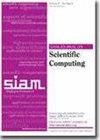Local Structure-Preserving Relaxation Method for Equilibrium of Charged Systems on Unstructured Meshes
IF 2.6
2区 数学
Q1 MATHEMATICS, APPLIED
引用次数: 0
Abstract
SIAM Journal on Scientific Computing, Volume 46, Issue 4, Page A2248-A2269, August 2024.Abstract. This work considers charged systems described by the modified Poisson–Nernst–Planck (PNP) equations, which incorporate ionic steric effects and the Born solvation energy for dielectric inhomogeneity. Solving the equilibrium of modified PNP equations poses numerical challenges due to the emergence of sharp boundary layers caused by small Debye lengths, particularly when local ionic concentrations reach saturation. To address this, we first reformulate the problem as a constraint optimization, where the ionic concentrations on unstructured Delaunay nodes are treated as fractional particles moving along edges between nodes. The electric fields are then updated to minimize the objective free energy while satisfying the discrete Gauss law. We develop a local relaxation method on unstructured meshes that inherently respects the discrete Gauss law, ensuring curl-free electric fields. Numerical analysis demonstrates that the optimal mass of the moving fractional particles guarantees the positivity of both ionic and solvent concentrations. Additionally, the free energy of the charged system consistently decreases during successive updates of ionic concentrations and electric fields. We conduct numerical tests to validate the expected numerical accuracy, positivity, free-energy dissipation, and robustness of our method in simulating charged systems with sharp boundary layers.
非结构网格上带电系统平衡的局部结构保持松弛法
SIAM 科学计算期刊》,第 46 卷第 4 期,第 A2248-A2269 页,2024 年 8 月。 摘要。本研究考虑了修正的泊松-诺恩斯特-普朗克(PNP)方程所描述的带电系统,其中包含离子立体效应和电介质不均匀性的玻恩溶解能。由于小德拜长度会导致尖锐边界层的出现,特别是当局部离子浓度达到饱和时,因此求解修正 PNP 方程的平衡会带来数值上的挑战。为解决这一问题,我们首先将问题重新表述为约束优化,将非结构化 Delaunay 节点上的离子浓度视为沿节点间边缘移动的分数粒子。然后更新电场,使目标自由能最小化,同时满足离散高斯定律。我们在非结构网格上开发了一种局部松弛方法,该方法本质上尊重离散高斯定律,确保电场无卷曲。数值分析表明,移动分数粒子的最佳质量保证了离子和溶剂浓度的正向性。此外,在连续更新离子浓度和电场的过程中,带电系统的自由能持续下降。我们进行了数值测试,以验证我们的方法在模拟具有尖锐边界层的带电系统时的预期数值精度、正向性、自由能耗散和稳健性。
本文章由计算机程序翻译,如有差异,请以英文原文为准。
求助全文
约1分钟内获得全文
求助全文
来源期刊
CiteScore
5.50
自引率
3.20%
发文量
209
审稿时长
1 months
期刊介绍:
The purpose of SIAM Journal on Scientific Computing (SISC) is to advance computational methods for solving scientific and engineering problems.
SISC papers are classified into three categories:
1. Methods and Algorithms for Scientific Computing: Papers in this category may include theoretical analysis, provided that the relevance to applications in science and engineering is demonstrated. They should contain meaningful computational results and theoretical results or strong heuristics supporting the performance of new algorithms.
2. Computational Methods in Science and Engineering: Papers in this section will typically describe novel methodologies for solving a specific problem in computational science or engineering. They should contain enough information about the application to orient other computational scientists but should omit details of interest mainly to the applications specialist.
3. Software and High-Performance Computing: Papers in this category should concern the novel design and development of computational methods and high-quality software, parallel algorithms, high-performance computing issues, new architectures, data analysis, or visualization. The primary focus should be on computational methods that have potentially large impact for an important class of scientific or engineering problems.

 求助内容:
求助内容: 应助结果提醒方式:
应助结果提醒方式:


